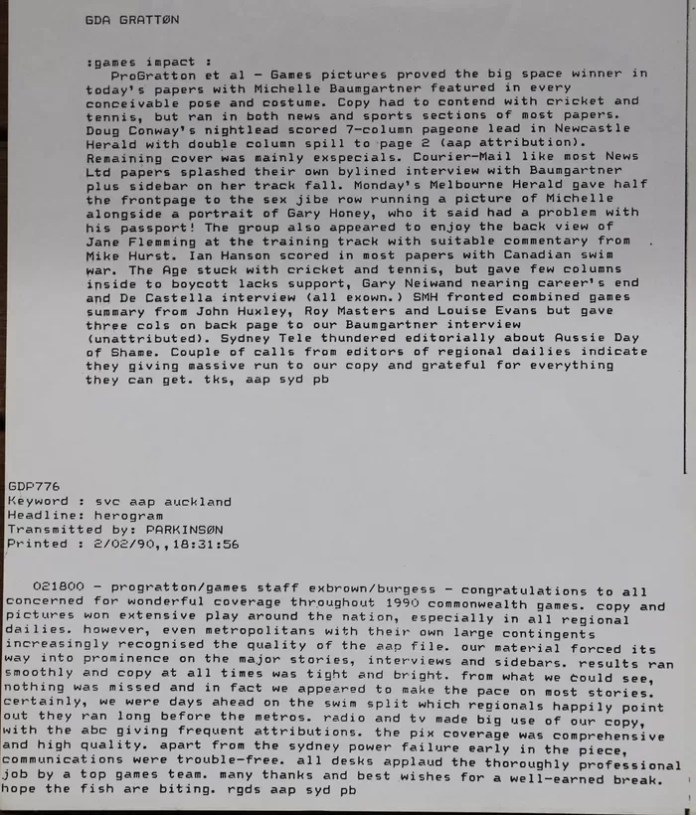The Australian Associated Press sent a team of 16 journalists, technicians, photographers and picture editors to the Auckland Commonwealth Games to provide photo pool coverage to Australian regional newspapers and the metropolitan press.

Three photographers were seconded from the Sydney Morning Herald and The Age, Norm and Wayne (I’m trying to track down their last names, please comment below if you know) and a teenaged Jack Atley.
The Auckland Commonwealth Games in 1990 was the first large event that AAP used their AP Leafax digital darkroom & portable transmitter.
This darkroom in a suitcase sped up the operation of transmitting photographs from Auckland back to AAP’s office in Sussex Street, Sydney.
Advertisement:
Australian Associated Press (AAP) picture editor’s story
The 35mm colour negative film was developed using a C41 machine available to all photographers by the Games Media Centre organisers.
The negative was then examined and edited using a loupe like the one shown here in the photo of legendary AP Picture Editor, Horst Faas.

The selected negative was cut into strips of three and inserted into the Leafax, then edited, corrected and captioned before sending to Sydney over dedicated phone lines.
Colour prints were also available to all news organisations from the Games Pool photographers, such as the photo shown below of Lisa Curry and her daughter taken by Australian photographer Brendan Read for the ‘pool’ photos available from the Games organisers.
Each colour image took approximately 25 minutes to send over the phone line to Sydney, and then on to the rest of Australia and the world.
AAP also had AP drum transmitters which were used to send print photos while the next image was loaded into the Leafax.

Sending a colour colour involved sending it three times, with a cyan, magenta and yellow filter on each ‘separation’. The corner crosshairs aligned the three separations in the newspaper’s CMY printer to produce a colour photo.
Also present in the picture editor’s room was 2 time Pulitzer winner Horst Faas as picture editor for Associated Press coverage for the Commonwealth countries and other interested in covering the sports.
Horst Faas was a renowned German photojournalist known for his powerful and evocative images, particularly during the Vietnam War. Working for the Associated Press, Faas captured some of the most iconic and harrowing moments of the conflict, bringing the realities of war to the global audience.
His work earned him two Pulitzer Prizes and made a significant impact on how wars were visually documented. Beyond his own photography, Faas was a mentor and guide to other photojournalists, and was picture editor for AP’s operation based in London, overseeing news and sports photography coverage for Europe, the Middle East and Africa for the Associated Press to distribute to the rest of the world
Pool Photographs
Foto Pacific provided the pool photos for the Commonwealth Games organising committee and AAP had access to those photos as well. These pool photos are shown in this feature series.
“Pool” photos are a collection of images made available by a select group of photographers who are granted exclusive access to large sporting events. These photos are then shared with various media outlets to ensure widespread coverage while minimizing the number of photographers present at the event.
This system is often used in major sporting events like the Olympics, World Cup, or Super Bowl, where logistical constraints or security concerns limit the number of photographers allowed on-site. By distributing pool photos, media organizations can provide comprehensive visual coverage of the event while maintaining a controlled and organized environment.

Sports photographer Jack Atley was a teen-aged member of the AAP photography crew, seconded from Fairfax, originally as a support person and he proved so adept at making photos in the boxing ring that he was given photo assignments.
The AAP staff covering the 1990 Auckland Commonwealth Games were: Tim Green, Mike Kosolowski, Jan Martin, Helen Corcoran, Geoff McCamey, Mike Hedge, Mike Osborne, Doug Conway, Reg Gratton, Terry O’Connor, Giles Parkinson, Anthony Carmichael, Tony Vermeer, Bruce Howard, Caryl Williamson, and Mark Anning.
Reg Gratton was National News Editor in the Sydney office of AAP. He sent daily play reports to the AAP team in Auckland on the impacts of their work in the Australian media. ‘Parkinson’ is Giles Parkinson, ‘pb’ is AAP’s Editor-In-Chief, Peter Brown who was in Sydney.
As the Australian Commonwealth Games team set records for the number of medals won, the Australian photographers had to set records for the numbers of photographs sent to the media.

Australian Associated Press
The Australian Associated Press (AAP) is Australia’s national news agency, providing comprehensive and reliable news coverage since its establishment in 1935. AAP serves as a critical source of news, photos, and data for media outlets across Australia and beyond, ensuring timely and accurate reporting on a wide range of topics, from politics and sports to business and entertainment.
The agency is known for its commitment to impartial journalism, maintaining a strong reputation in the industry. In addition to news reporting, AAP also offers media services, including fact-checking, media monitoring, and digital content production, making it an essential pillar of the Australian media landscape.
Thank you for reminiscing with me. Your humble scribe, Mark Anning.
Further Reading – from Amazon
XIVth Commonwealth Games: the official history, Auckland 1990
The Commonwealth Games: the first 60 years, 1930-1990 by Cleve Dheenshaw
The Commonwealth Games: The First 60 Years, 1930-1990 by Cleve Dheensaw (Paperback – December 1994)
Photos, Stories and Pages in this feature series:
The Ceremony | The Pool | The Track & Field | Jason Statham diving | The Green | The Range | The Ring | The Velodrome | The Picture Editor’s Desk




